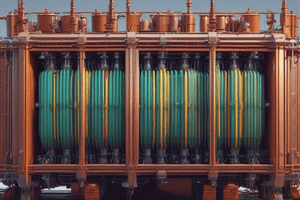Podcast
Questions and Answers
Which of the following properties is NOT a desirable characteristic for resistance wire in heating elements?
Which of the following properties is NOT a desirable characteristic for resistance wire in heating elements?
- Low melting point (correct)
- High electrical resistivity
- High resistance to oxidation
- Mechanical robustness
What is the primary reason why nichrome is a commonly used material for heating element resistance wires?
What is the primary reason why nichrome is a commonly used material for heating element resistance wires?
- It has a low melting point, which allows for quick heating.
- It possesses high resistivity and a high melting point, suitable for high-temperature applications. (correct)
- It is highly malleable and easy to form into different shapes.
- It is inexpensive and readily available.
What is the relationship between the length and diameter of a resistance wire and its heat output?
What is the relationship between the length and diameter of a resistance wire and its heat output?
- A shorter and thinner wire produces less heat. (correct)
- A longer and thicker wire produces more heat.
- A longer and thicker wire produces less heat.
- The length and diameter have no effect on heat output.
Why would ceramic materials be considered for specialized heating applications?
Why would ceramic materials be considered for specialized heating applications?
How does the intended use of a heating element, like a stovetop burner or a space heater, influence the selection of resistance wire?
How does the intended use of a heating element, like a stovetop burner or a space heater, influence the selection of resistance wire?
What is the main purpose of a coating or insulation on resistance wire?
What is the main purpose of a coating or insulation on resistance wire?
Which of the following is an example of a material commonly used as resistance wire in heating elements?
Which of the following is an example of a material commonly used as resistance wire in heating elements?
What is the primary function of the cross-sectional shape of resistance wire?
What is the primary function of the cross-sectional shape of resistance wire?
Flashcards
Electrical Resistivity
Electrical Resistivity
A measure of how strongly a material opposes electric current flow.
Resistance Wire
Resistance Wire
Wires used in heating elements that generate heat from electric current.
Nichrome
Nichrome
An alloy of nickel and chromium, commonly used in resistance wires.
Kanthal
Kanthal
Signup and view all the flashcards
Diameter and Length Impact
Diameter and Length Impact
Signup and view all the flashcards
Cross-Sectional Shape
Cross-Sectional Shape
Signup and view all the flashcards
Mechanical Robustness
Mechanical Robustness
Signup and view all the flashcards
Coating and Insulation
Coating and Insulation
Signup and view all the flashcards
Study Notes
Material Properties
- Resistance wires in electric heating elements are typically made from materials with high electrical resistivity, which is a measure of how strongly a material opposes the flow of electric current.
- This high resistivity translates into a greater ability to generate heat when an electric current flows through it.
- Materials with high resistivity and high melting points are preferred to withstand the high temperatures encountered during operation.
Common Materials
- Nichrome (an alloy of nickel and chromium) is a very common choice for resistance wire in heating elements due to its high resistivity, high melting point, and good resistance to oxidation at high temperatures.
- Other alloys, like Kanthal (an iron-chromium-aluminum alloy), also exhibit excellent high-temperature properties and are used in some applications.
- Metal resistance wires are common, but in some specialized applications, ceramic materials with high resistivity might be employed.
Factors Influencing Selection
- The specific alloy chosen depends on the desired operating temperature and the application. Some alloys are better suited for tasks involving more extreme temperatures and environments.
- The diameter and length of the wire will impact the overall resistance and heat output. A thinner and shorter wire will have less resistance and generate less heat compared to a thicker and longer wire.
- The intended use of the heating element (e.g., a stovetop burner vs. a space heater) will also have a considerable impact on the specifications of the resistive wire. A smaller space heater would use a thinner wire, for instance.
Manufacturing Considerations
- Resistance wires typically have a particular cross-sectional shape to maximize surface area when exposed for optimal heat delivery.
- The wire needs to be mechanically robust to tolerate stresses, vibrations, and impacts during its use in the heating element.
- The wire often has a specific coating or insulation to protect it from corrosion and to enhance its longevity.
Studying That Suits You
Use AI to generate personalized quizzes and flashcards to suit your learning preferences.




